曹工杂谈:我们的应用,启动就要去其他服务拉数据,那其他服务挂了,我们就起不来了?
曹工杂谈:我们的应用,启动就要去其他服务拉数据,那其他服务挂了,我们就起不来了?
前言
在大家的项目中,想必都有那种,启动时候要去其他服务拉一些数据的情况,如果我们启动时,其他服务没启动,按岂不是就起不来了吗,如果这段拉数据的代码,并不是核心业务,那你这就有点说不过去了:不能因为对方没启动,我们也不能启动吧?
经过一些思考后,我觉得可以这样,启动的时候:
- 启动一个定时的线程池,让它去执行拉数据的任务,如果任务执行失败,会过一段时间后再次执行
- 我们希望,一旦某一次执行任务,成功后,就不要再去拉数据了,浪费网络流量和cpu
我这边可以大概就大家演示下。
示例代码
服务端
随便写了个spring boot服务端,监听本机8082端口。模拟第三方服务
@RestController
@Slf4j
public class BusinessController {
@GetMapping("/")
public String test() {
return "success";
}
}
@SpringBootApplication
@Slf4j
public class WebDemoApplicationServer {
public static void main(String[] args) {
ConfigurableApplicationContext context = SpringApplication.run(WebDemoApplicationServer.class, args);
}
}
客户端
客户端程序,依赖第三方服务,启动时,要去上面的服务端拉数据。
代码和上面差不多,唯一是在启动时,会执行以下逻辑:
@Component
public class InitRunner implements CommandLineRunner{
private static final Logger log = LoggerFactory.getLogger(InitRunner.class);
@Autowired
private RestTemplate restTemplate;
@Override
public void run(String... args) throws Exception {
ResponseEntity<String> entity = restTemplate.getForEntity("http://localhost:8082", String.class);
String s = entity.toString();
log.info("get data:{}",s);
}
}
在上面的服务没启动的时候,这个客户端是起不来的。
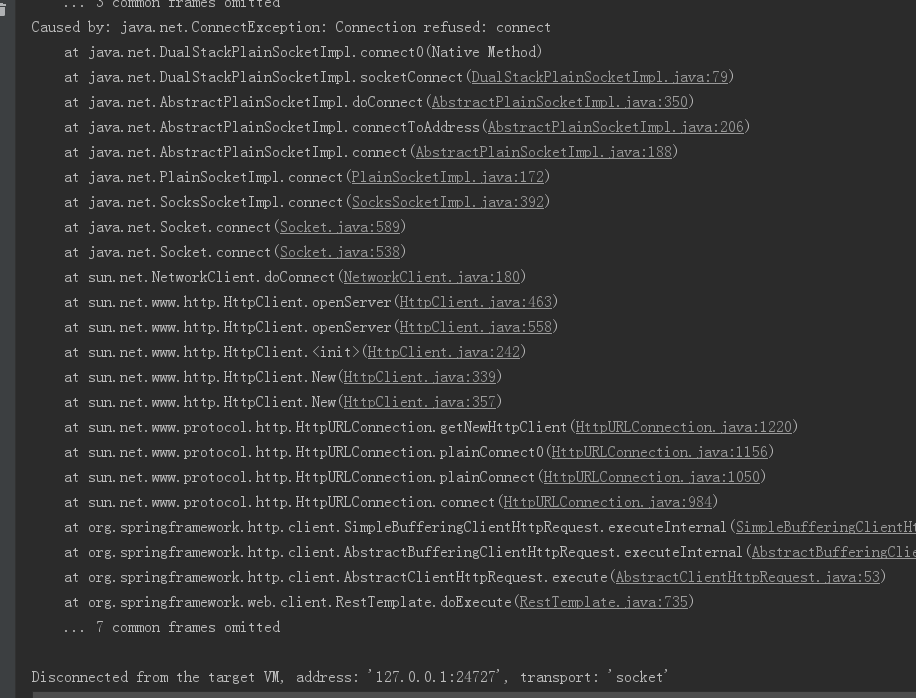
怎么解决呢,很简单。
方案1
public class InitRunnerV2 implements CommandLineRunner {
@Autowired
private RestTemplate restTemplate;
// 1
ScheduledThreadPoolExecutor scheduledThreadPoolExecutor =
new ScheduledThreadPoolExecutor(1, new NamedThreadFactory("init-data-from-third-sys"));
@Override
public void run(String... args) {
//2
TestTask task = new TestTask(restTemplate);
//3
ScheduledFuture<?> scheduledFuture = scheduledThreadPoolExecutor.scheduleAtFixedRate(task,
0, 10, TimeUnit.SECONDS);
// 4
task.setScheduledFuture(scheduledFuture);
}
}
-
1处,new了一个线程池,ScheduledThreadPoolExecutor类型,可周期执行某个任务
-
2处,new了一个任务,这个任务会执行我们的拉数据逻辑。
这个任务的代码如下:
@Slf4j public class TestTask implements Runnable{ private RestTemplate restTemplate; private volatile ScheduledFuture<?> scheduledFuture; public TestTask(RestTemplate restTemplate) { this.restTemplate = restTemplate; } ... public void setScheduledFuture(ScheduledFuture<?> scheduledFuture) { this.scheduledFuture = scheduledFuture; } }其实很简单,就是定义了2个字段,一个是RestTemplate,请求数据时要用;另一个是ScheduledFuture<?>类型,这个字段在上面的
InitRunnerV2代码的第三处被赋值。 -
3处,让这个任务循环执行,每10s一次。
-
4处,给task的
ScheduledFuture赋值,注意的是,在task中,这个字段我们定义为volatile,保证线程可见。
下面是任务代码的剖析:
@Override
public void run() {
try {
ResponseEntity<String> entity = restTemplate.getForEntity("http://localhost:8082", String.class);
String s = entity.toString();
log.info("get data:{}",s);
} catch (Exception e) {
// log.error("e:{}",e);
log.error("error");
return;
}
/**
* 1 有可能任务执行太快,future还没被赋值
*/
if (scheduledFuture != null) {
scheduledFuture.cancel(true);
}
}
唯一有什么要说的,就是1处,如果成功了,我们就会调用 scheduledFuture.cancel(true); ,这样,这个scheduled 任务就不会继续执行了,也就达到了我们的目的,经济实惠。
到此,代码基本就这样了,详细代码见:
https://gitee.com/ckl111/all-simple-demo-in-work/tree/master/spring-boot-scheduler-future-demo-parent
不成熟方案2
因为上面的方案挺简单实用,但感觉没啥干货,于是我想着是否可以自己来实现一个定制的线程池,把这些事情给自动化了。
希望实现的最终效果如下,给future增加一个回调,需要在任务执行成功时,该回调自动被调用:
public class InitRunnerV3 implements CommandLineRunner {
@Autowired
private RestTemplate restTemplate;
CustomScheduledThreadPoolExecutor scheduledThreadPoolExecutor =
new CustomScheduledThreadPoolExecutor(1, new NamedThreadFactory("init-data-from-third-sys"));
@Override
public void run(String... args) {
// 1
TestTaskV3 task = new TestTaskV3(restTemplate);
// 2
CustomScheduledFuture<?> scheduledFuture = scheduledThreadPoolExecutor.scheduleAtFixedRate(task,
0, 10, TimeUnit.SECONDS);
// 3
scheduledFuture.setCustomFutureCallBack(new CustomFutureCallBack() {
@Override
public void onSuccess(CustomScheduledFuture customScheduledFuture) {
log.info("onSuccess");
// 4
customScheduledFuture.cancel(true);
}
@Override
public void onException(Throwable throwable) {
log.error("e:{}",throwable);
}
});
}
-
1处,执行任务,任务内部如下,去除了设置future的逻辑,和取消的逻辑
@Slf4j public class TestTaskV3 implements Runnable{ private RestTemplate restTemplate;public TestTaskV3(RestTemplate restTemplate) { this.restTemplate = restTemplate; } @Override public void run() { try { ResponseEntity<String> entity = restTemplate.getForEntity("http://localhost:8082", String.class); String s = entity.toString(); log.info("get data:{}",s); } catch (Exception e) { // log.error("e:{}",e); log.error("error"); throw e; } } } -
2处,循环执行任务,这里的scheduled线程池,是我们自定义的,回头再说;获取其返回的future
-
3处,给future增加回调,在回调中,如果成功,则取消该任务。
@Override public void onSuccess(CustomScheduledFuture customScheduledFuture) { log.info("onSuccess"); // 4 customScheduledFuture.cancel(true); }
寻找扩展点
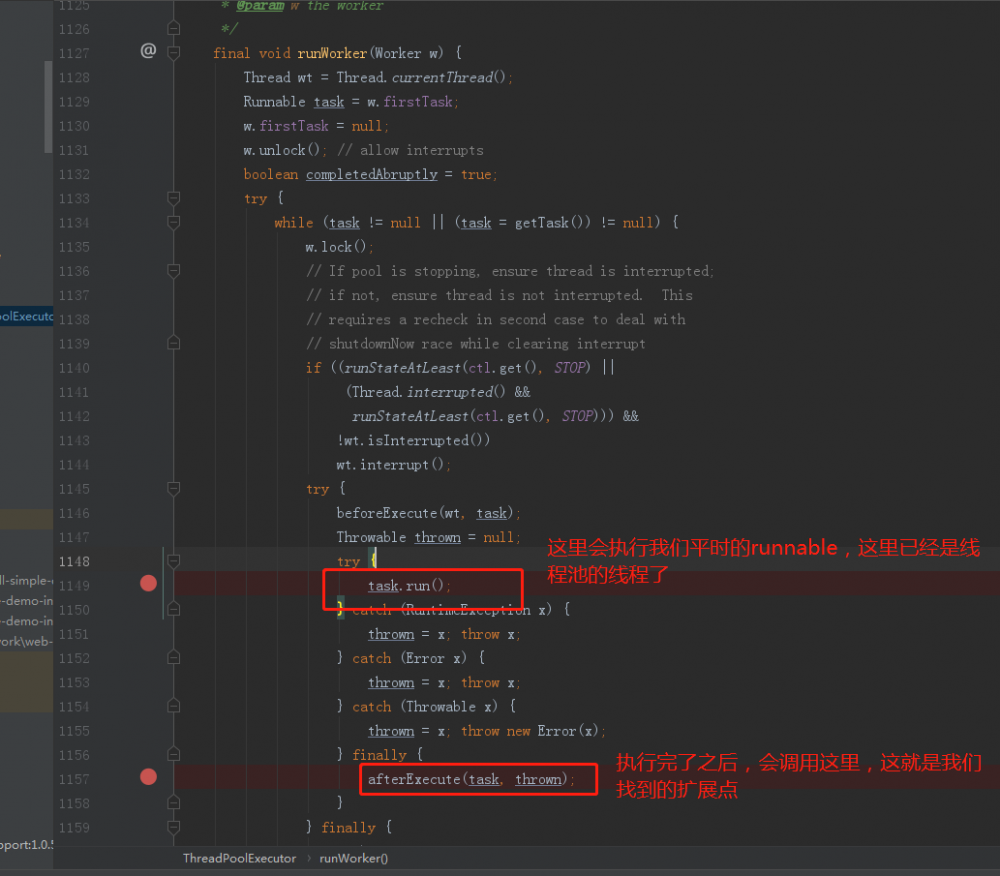
这里,afterExecute是个空实现,就是留给子线程池扩展用的:
protected void afterExecute(Runnable r, Throwable t) { }
那我们可以考虑下,要怎么才能实现我们的目标呢,我们要在这个方法内,通过传进来的 Runnable r ,获取到下面这个future才能实现目的:
CustomScheduledFuture<?> scheduledFuture = scheduledThreadPoolExecutor.scheduleAtFixedRate(task,
0, 10, TimeUnit.SECONDS);
获取到future,就能拿到在future上设置的callback对象,就能调用callback,所以,现在问题是,要在传进来的Runnable中,获取到 scheduledFuture 。
所以,我们就得包装一下,传进来的runnable,我们定义了如下的Runnable:
@Data
public class CustomDecoratedRunnable implements Runnable {
Runnable runnable;
CustomScheduledFuture customScheduledFuture;
public CustomDecoratedRunnable(Runnable runnable,CustomScheduledFuture customScheduledFuture) {
this.runnable = runnable;
this.customScheduledFuture = customScheduledFuture;
}
@Override
public void run() {
this.runnable.run();
}
}
定制线程池
我们具体看看,我们定制的线程池对象,我们的线程池,直接继承了 ScheduledThreadPoolExecutor :
public class CustomScheduledThreadPoolExecutor<V> extends ScheduledThreadPoolExecutor {
public CustomScheduledThreadPoolExecutor(int corePoolSize, ThreadFactory threadFactory) {
super(corePoolSize, threadFactory);
}
...
}
其 scheduleAtFixedRate 方法,我们进行了重写:
@Override
public CustomScheduledFuture<V> scheduleAtFixedRate(Runnable command, long initialDelay, long period, TimeUnit unit) {
/**
* 1
*/
CustomScheduledFuture customScheduledFuture = new CustomScheduledFuture();
// 2 将future设置到task中
CustomDecoratedRunnable customDecoratedRunnable = new CustomDecoratedRunnable(command,customScheduledFuture);
// 3
ScheduledFuture<?> scheduledFuture = super.scheduleAtFixedRate(customDecoratedRunnable,
initialDelay, period, unit);
/**
* 4 将返回的future,设置到我们包装过的future
*/
customScheduledFuture.setScheduledFuture((RunnableScheduledFuture) scheduledFuture);
return customScheduledFuture;
}
-
1处,新建一个自定义的future
-
2处,将自定义的future,设置到上面说的task中
-
3处,把包装过的task,丢给线程池
-
4处,返回一个定制的future,这个future,包装了原有的future,同时,支持设置callback
public class CustomScheduledFuture<V> implements RunnableScheduledFuture<V> { /** * 其实是下面这种类型: * {@link java.util.concurrent.ScheduledThreadPoolExecutor.ScheduledFutureTask * */ RunnableScheduledFuture<V> scheduledFuture; // 设置callback时,赋值 CustomFutureCallBack customFutureCallBack; Runnable runnable; }
丢给定制线程池的task
本来,我以为,丢给线程池什么Runnable对象,在afterExecute就能拿到什么样的Runnable对象,结果:
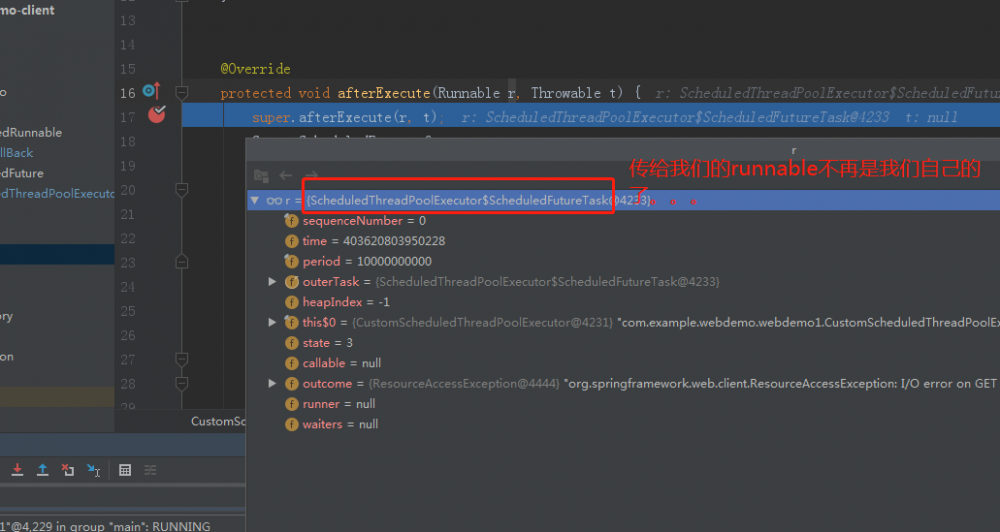
发现,传进来的,已经被包装过了,应该是为了支持周期执行。
所以,没办法,看起来路被堵死了,通过这个传进来的Runnable,也拿不到我们原始的Runnable。
后边找了半天,找到下面这个点:
#java.util.concurrent.ScheduledThreadPoolExecutor#scheduleAtFixedRate
public ScheduledFuture<?> scheduleAtFixedRate(Runnable command,
long initialDelay,
long period,
TimeUnit unit) {
if (command == null || unit == null)
throw new NullPointerException();
if (period <= 0)
throw new IllegalArgumentException();
ScheduledFutureTask<Void> sft =
new ScheduledFutureTask<Void>(command,
null,
triggerTime(initialDelay, unit),
unit.toNanos(period));
// 1
RunnableScheduledFuture<Void> t = decorateTask(command, sft);
sft.outerTask = t;
delayedExecute(t);
return t;
}
-
1处,会调用decorateTask来包装task,默认实现,就是如下:
protected <V> RunnableScheduledFuture<V> decorateTask( Runnable runnable, RunnableScheduledFuture<V> task) { return task; }这里的task,就是前面那个代码里的
ScheduledFutureTask<Void> sft:ScheduledFutureTask<Void> sft = new ScheduledFutureTask<Void>(command, null, triggerTime(initialDelay, unit), unit.toNanos(period)); // 1 RunnableScheduledFuture<Void> t = decorateTask(command, sft);
所以,我们得想办法重载这个方法:
@Override
protected <V> RunnableScheduledFuture<V> decorateTask(Runnable runnable, RunnableScheduledFuture<V> task) {
CustomScheduledFuture<V> future = new CustomScheduledFuture<>();
future.setRunnable(runnable);
future.setScheduledFuture(task);
return future;
}
这里,利用CustomScheduledFuture,封装了task和runnable两个对象。
同时,我们自定义的这个 CustomScheduledFuture ,也是实现了这个方法的返回值,指定的接口:
@Data public class CustomScheduledFuture<V> implements RunnableScheduledFuture<V>
目前为止,经过包装后,在afterExecute处,拿到的Runnable如下:
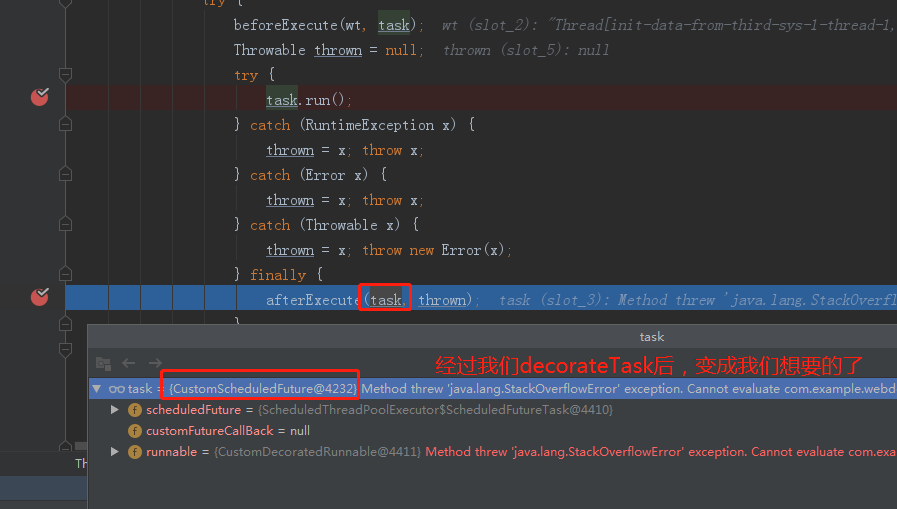
afterExecute的逻辑,调用回调
@Override
protected void afterExecute(Runnable r, Throwable t) {
super.afterExecute(r, t);
CustomScheduledFuture future;
CustomDecoratedRunnable runnable = null;
if (r instanceof CustomScheduledFuture) {
future = (CustomScheduledFuture) r;
// 1
runnable = (CustomDecoratedRunnable) future.getRunnable();
}
// 2
CustomScheduledFuture customScheduledFuture = runnable.getCustomScheduledFuture();
// 3
CustomFutureCallBack customFutureCallBack = customScheduledFuture.getCustomFutureCallBack();
if (customFutureCallBack != null) {
if (t != null) {
customFutureCallBack.onException(t);
} else {
// 4
customFutureCallBack.onSuccess(customScheduledFuture);
}
}
}
- 1处,获取runnable
- 2处,根据runnable,获取我们的future
- 3处,通过future,获取回调
- 4处,调用回调
效果展示
2020-04-10 09:45:28.068 INFO 14456 --- [ main] No active profile set, falling back to default profiles: default 2020-04-10 09:45:28.822 INFO 14456 --- [ main] Started WebDemoApplication in 1.153 seconds (JVM running for 1.805) 2020-04-10 09:45:36.933 ERROR 14456 --- [init-data-from-third-sys-1-thread-1] error 2020-04-10 09:48:48.975 INFO 14456 --- [init-data-from-third-sys-1-thread-1] onSuccess
可以看到,任务执行失败了,但为啥会调用onSuccess呢;另外,大家可以看到,都是在线程池的线程中执行的。
为啥会error了,还执行success呢,我发现,即使我在task中抛出了异常,但是上层没捕获。
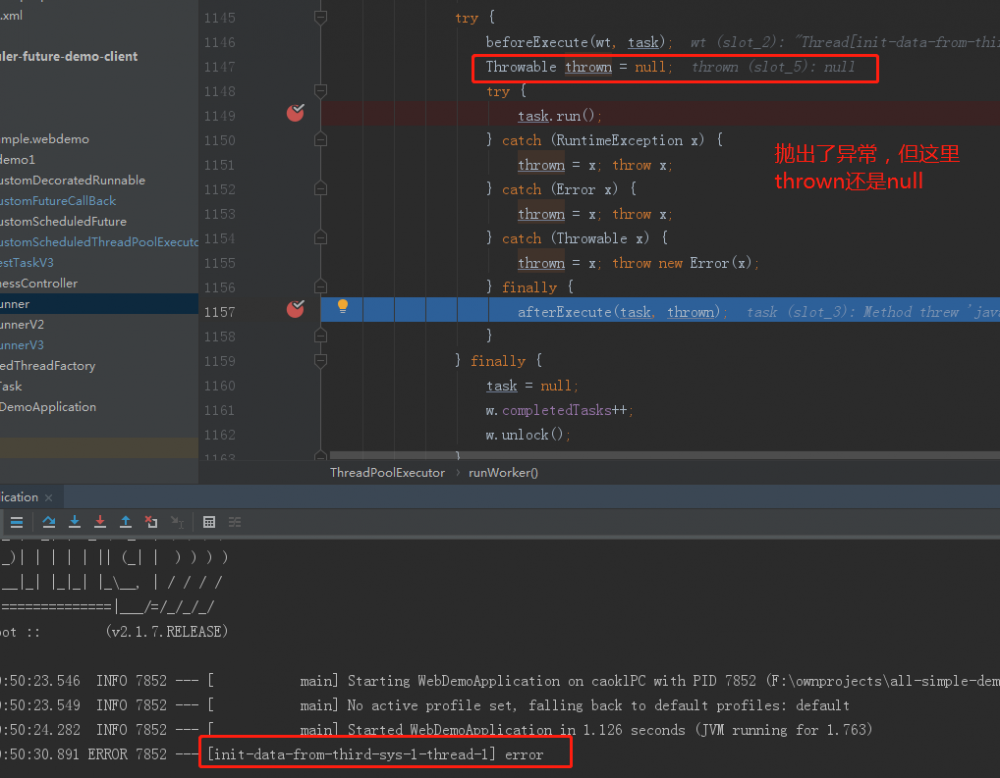
我猜测,是因为:
public interface Runnable {
/**
* When an object implementing interface <code>Runnable</code> is used
* to create a thread, starting the thread causes the object's
* <code>run</code> method to be called in that separately executing
* thread.
* <p>
* The general contract of the method <code>run</code> is that it may
* take any action whatsoever.
*
* @see java.lang.Thread#run()
*/
public abstract void run();
}
这里没有抛出异常,所以,即使实现的runnable中抛了,上层也不管。
具体还要验证。
注意点
另一个点是,执行失败了,等了10s,并没有再次执行,猜测是我的定制task,导致了周期执行的问题。这个待验证和解决。
但,一个简单的回调,我们已经实现了。
总结
大家使用方案1 就可以了;后面的方案,是折腾着玩的。希望对大家有帮助。
全部代码都在:
https://gitee.com/ckl111/all-simple-demo-in-work/tree/master/spring-boot-scheduler-future-demo-parent
- 本文标签: volatile spring ACE id tar CEO src 端口 executor JVM UI REST http 服务端 时间 ThreadPoolExecutor 定制 Action bus map HTML ask https Master 代码 总结 web 线程池 springboot cat App core git 希望 IDE final java trigger Spring Boot 线程 CTO entity 自动化 IO 数据
- 版权声明: 本文为互联网转载文章,出处已在文章中说明(部分除外)。如果侵权,请联系本站长删除,谢谢。
- 本文海报: 生成海报一 生成海报二










![[HBLOG]公众号](https://www.liuhaihua.cn/img/qrcode_gzh.jpg)

